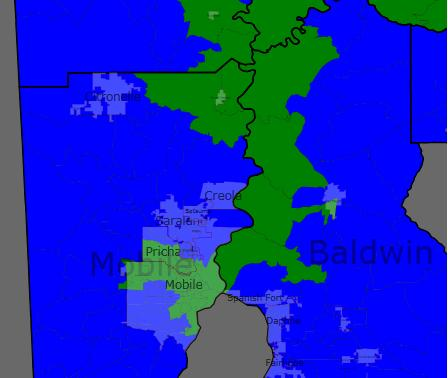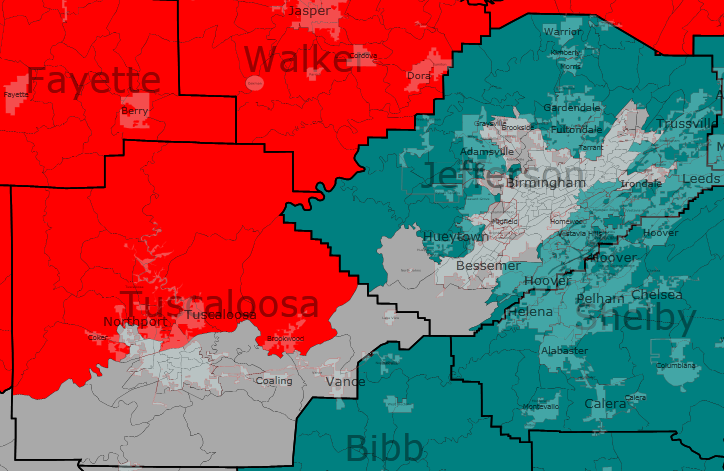There are a few scenarios which could give rise to this map. If control of redistricting is split, then I could see this as a compromise map. As you'll soon see, Mike Rogers' life gets easier while the Second District becomes solidly Democratic (albeit with Bobby Bright is serious trouble in the primary, assuming he's still around).
Even if Democrats have the redistricting trifecta, the fact that only one of the state's seven districts can be counted on to go Democratic and only one another saw Obama get more than 40% of the vote has got to be worrisome. So, a map such as this can also be seen as a Democratic gerrymander of sorts in that it makes two solidly Democratic districts.
I could even see this as a Republican map, especially if Bobby Bright survives. If that happens, they could concede the Second in return for shoring up their most vulnerable member: Mike Rogers.
Finally, this map could result from a decision by the courts or the Justice Department mandating that Alabama have another black-majority district. 2005 Census estimates put Alabama at 26.7% black. That amounts to just under two districts, and considering that adding another majority black district to Alabama is fairly easy as the heavily black areas tend to be clustered or at least fairly close to each other.



First District (Blue)
Old District: 67.8% white | 28% black
Old Demographics: 82% white | 13% black
New Demographics: 81% white | 13% black
The First exchanges heavily black areas in Mobile for rural, white areas along the Florida border. The net result is a significantly whiter and probably more Republican district, as if Jo Bonner needed it.
Second District (Green)
Old District: 67% white | 29% black
Old Demographics: 44% white | 53% black
New Demographics: 41% white | 55% black
Previous attempts to move the black areas of Mobile to the Seventh District and move extra black areas from the Seventh to the Second were unsuccessful as it left the First and Second underpopulated with nowhere to gain that wouldn’t negate the whole purpose. But moving this area into the Second does work. The Second also picks up heavily black areas from the Seventh and Third and loses whiter areas to the First and Third. As a result, the district is now majority black and, I would assume, pretty solidly Democratic. Bobby Bright would likely have trouble in the primary, though.
Third District (Purple)
Old District: 65% white | 32% black
Old Demographics: 74% white | 22% black
New Demographics: 73% white | 23% black
Things get easier for Mike Rogers. Not only has the district been pushed northward out of the black belt (or at least the blackest parts of it), becoming almost three-quarters white, but Rogers' Democratic opponent Josh Segall is now in the Second District.
Fourth District (Red)
Old District: 90% white | 5% black
Old Demographics: 90% white | 6% black
New Demographics: 88% white | 6% black
The Fourth remains Alabama's whitest and least diverse districts. I tried to make it a heavily rural district, which you may can see in its loss of Fort Payne and Gadsden. That effort may have been futile as I had to put Florence and parts of Tuscaloosa in the district. I would be shocked if Rob Aderholt had any problems here.
Fifth District (Yellow)
Old District: 78% white | 17% black
Old Demographics: 79% white | 15% black
New Demographics: 76% white | 16% black
With this one, I tried to make it more urban (or at least less rural) as well as concentrate the military interests in one district. The new Fifth picks of Decatur and Fort Payne, among other areas, and sheds some more rural areas.
Sixth District (Teal)
Old District: 89% white | 8% black
Old Demographics: 88% white | 8% black
New Demographics: 85% white | 10% black
With the loss of Tuscaloosa County, the Sixth loses much of its former serpentine shape. With the addition of Autauga County, the district becomes more of a Birmingham to Montgomery district.
Seventh District (Gray)
Old District: 36% white | 62% black
Old Demographics: 37% white | 60% black
New Demographics: 35% white | 61% black
Not a whole lot has changed here. It loses some of Clarke County, giving the district a more compact look, as well as parts of Pickens and Wilcox Counties. In return, it gains some Birmingham-area precincts. The story is still the same: heavily black and solidly Democratic.